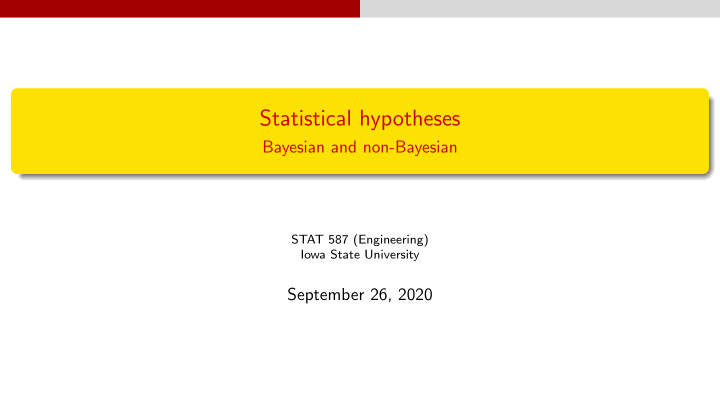



Statistical hypotheses Bayesian and non-Bayesian STAT 587 (Engineering) Iowa State University September 26, 2020
Statistical hypotheses Statistical hypothesis A statistical hypothesis is a model for data. For example, Y ∼ Ber ( θ ) or Y ∼ Bin (10 , 0 . 25) or ind ∼ N (0 , σ 2 ) Y i or ind ∼ N ( µ, σ 2 ) . Y i
Statistical hypotheses Translating a scientific hypothesis into a statistical hypothesis Translating a scientific hypothesis into a statistical hypothesis Scientific hypothesis: the coin is fair Statistical hypothesis: Let Y be an indicator that the coin is flipped heads. Y ∼ Ber (0 . 5) Scientific hypothesis: the coin is biased, but we don’t know the probability Statistical hypothesis: Y ∼ Ber ( θ ) .
Statistical hypotheses Null hypothesis Null hypothesis Wikipedia definition: the null hypothesis, H 0 , is the [model] that there is no relationship between two measured phenomena or no association among groups My definition: the null hypothesis is the straw man model that nobody believes is true For example, the coin is fair H 0 : Y ∼ Bin (0 . 5) .
Statistical hypotheses Alternative hypothesis Alternative hypothesis Wikipedia definition: the alternative hypothesis, H A , is [the model] that states something is happening, a new theory is preferred instead of an old one (null hypothesis). My definition: the alternative hypothesis is the model that the researcher believes For example, the coin is biased, but we don’t know the probability H A : Y ∼ Ber ( θ )
Statistical hypotheses Null vs alternative hypothesis Null vs alternative hypothesis We typically simplify notation and write null and alternative hypotheses like this: Model: Y ∼ Ber ( θ ) Hypotheses: H 0 : θ = 0 . 5 versus H A : θ � = 0 . 5 I prefer H 0 : Y ∼ Ber (0 . 5) versus H A : Y ∼ Ber ( θ ) so that we remind ourselves that these hypotheses are models.
Bayesian hypotheses Bayesian hypotheses Bayesian hypotheses are full probability models for the data. For example, Y ∼ Ber (0 . 5) or Y | θ ∼ Ber ( θ ) and θ ∼ Be ( a, b ) for known values of a and b .
Bayesian hypotheses Prior predictive distribution The prior predictive distribution is the distribution for the data with all the parameters integrated out, i.e. � p ( y ) = p ( y | θ ) p ( θ ) dθ. For example, if Y | θ ∼ Ber ( θ ) and θ ∼ Be ( a, b ) then p ( y ) = � p ( y | θ ) p ( θ ) dθ � 1 0 y θ (1 − y ) 1 − θ Beta ( a,b ) θ a − 1 (1 − θ ) b − 1 dθ 1 = � 1 1 0 θ a + y − 1 (1 − θ ) b + n − y − 1 dθ = Beta ( a,b ) = Beta ( a + y,b + n − y ) Beta ( a,b ) which is the probability mass function for the beta-binomial distribution.
Bayesian hypotheses Comments Comments Three points about Bayesian hypotheses: Must use proper priors. No special hypotheses. Not restricted to 2 hypotheses.
Summary Summary Model: Y ∼ Ber ( θ ) Null hypothesis: H 0 : θ = 0 . 5 Alternative hypothesis: H A : θ � = 0 . 5
Recommend
More recommend